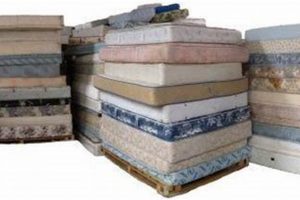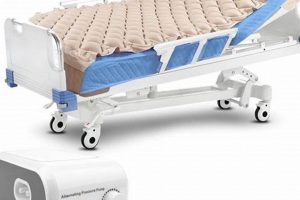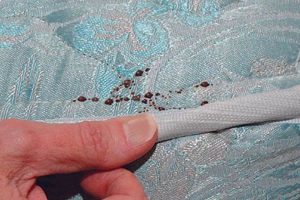The dimensions of bedding designed for a transitional bed frame, typically used by children moving from a crib to a larger sleeping arrangement, require specific measurements. These mattresses are generally smaller than a standard single and larger than a crib mattress. For example, a typical specification is 70 cm wide and 140 cm long.
Adherence to designated measurements is essential for safety, comfort, and the proper fit within the bed frame. A well-fitted mattress eliminates gaps where a child could become trapped, promoting restful sleep and ensuring the longevity of both the mattress and the bed. Historically, these dimensions evolved to accommodate the growing needs of toddlers while remaining space-efficient for smaller bedrooms.
The subsequent sections will explore factors influencing the choice of bedding material, considerations for optimal support and comfort, and a guide to selecting the appropriate bedding based on a child’s individual needs and developmental stage.
Essential Considerations for Junior Bed Mattress Dimensions
The following guidance assists in making informed decisions regarding bedding designed for transitional beds. Prioritizing correct measurements and appropriate materials is crucial for ensuring safety and comfort.
Tip 1: Verify Frame Compatibility: Always confirm that the mattress dimensions precisely match the internal measurements of the junior bed frame. Mismatched sizes can create hazardous gaps.
Tip 2: Consider Child’s Growth Trajectory: Factor in the child’s anticipated growth rate. Selecting a slightly larger size within safe limits may extend the mattress’s usability.
Tip 3: Prioritize Support and Firmness: Opt for a mattress that provides adequate support for a child’s developing spine. A firmer surface is generally recommended for younger children.
Tip 4: Assess Material Composition: Evaluate the materials used in the mattress construction. Hypoallergenic and breathable materials can minimize allergy risks and promote comfortable sleep.
Tip 5: Evaluate Edge Support: Check for reinforced edges to prevent sagging and provide stable support when a child sits or lies near the edge of the bed.
Tip 6: Measure Before Purchase: Accurate measurements of the bed frame’s interior space are essential before acquiring a mattress. This prevents the inconvenience of returns and ensures a secure fit.
Tip 7: Research Industry Standards: Familiarize yourself with relevant safety standards and certifications applicable to children’s mattresses. Compliance with these standards indicates a commitment to safety and quality.
Adhering to these recommendations promotes both safety and well-being. A properly sized and supportive mattress is a crucial element in a child’s transition to a larger bed.
The final section of this article will summarize the key points discussed and provide additional resources for further research.
1. Precise Measurements
The term “junior bed mattress size” inherently relies on precise measurements. Any deviation from the intended dimensions compromises the functionality and safety of the bed. Accurate measurements are not merely a recommendation but a fundamental requirement for proper fit within a designated junior bed frame. Failure to adhere to specified dimensions can result in gaps between the mattress and the frame, posing a risk of entrapment for the child. For instance, if a mattress is even slightly undersized, a child could potentially become wedged in the resulting space, leading to injury. Conversely, an oversized mattress may not fit within the frame, rendering it unusable and potentially damaging both the mattress and the bed.
The practical significance of precise measurements extends beyond immediate safety concerns. A well-fitted mattress, achieved through adherence to accurate dimensions, contributes to optimal comfort and support. When a mattress fits snugly within the frame, it distributes weight evenly, preventing sagging or uneven wear. This, in turn, prolongs the lifespan of the mattress and maintains its intended level of support. Consider the example of a mattress that is too short for the frame; this can lead to concentrated pressure points and discomfort for the child, potentially disrupting sleep and affecting spinal alignment. Conversely, if the mattress is too wide, it may be compressed against the frame, altering its firmness and compromising its ability to provide adequate support.
In summary, the importance of precise measurements in the context of “junior bed mattress size” cannot be overstated. Accurate dimensions are crucial for safety, comfort, support, and the overall longevity of the bedding and bed frame. Challenges in achieving precise measurements may arise from variations in manufacturing tolerances or inaccuracies in bed frame specifications. However, diligent measurement verification and adherence to established standards are essential for mitigating these risks and ensuring a safe and comfortable sleeping environment for the child. Understanding this interdependency links directly to the broader theme of responsible and informed purchasing decisions when selecting bedding for young children.
2. Frame Compatibility
Frame compatibility is an inseparable element of junior bed selection predicated on mattress size. A “junior bed mattress size” specification exists to ensure a secure and functional fit within a designated bed frame. The dimensions of the mattress must correspond precisely with the interior measurements of the frame to prevent hazardous gaps. For instance, a mattress designed to be 70 cm wide and 140 cm long is only suitable for a frame built to accommodate those precise measurements. If the mattress is too small, gaps arise, presenting a risk of entrapment. If the mattress is too large, it will not fit within the frame, or it will be forced to contort into the available space, diminishing its structural integrity and affecting support.
The practical impact of mismatched dimensions is significant. Consider a scenario where a frame is designed for a 70 cm x 140 cm mattress, but a 65 cm x 135 cm mattress is installed. The resulting gaps could allow a child to become wedged between the mattress and frame, potentially leading to suffocation or injury. Conversely, an oversized mattress forced into a smaller frame may cause the frame to warp or break over time, compromising its structural integrity and potentially collapsing. Therefore, confirming frame compatibility is not merely a suggestion but a safety imperative. The consequences of neglecting this consideration extend beyond inconvenience, impacting the physical well-being of the bed’s occupant and the overall durability of the furniture.
In summary, the “junior bed mattress size” is inherently linked to frame compatibility. The dimensions of the mattress are defined by and for the desig
nated frame, and any deviation from these specifications introduces risk. While manufacturing tolerances and variations in frame construction may pose challenges, accurate measurement and verification are crucial steps in ensuring a safe and functional sleep environment. This understanding underscores the need for diligent product selection and assembly when furnishing a child’s bedroom, emphasizing safety over convenience.
3. Child's Growth
The relationship between a child’s growth and appropriate mattress dimensions is a fundamental consideration when selecting bedding. Junior bed mattress size must accommodate the physical development of a child transitioning from a crib to a larger bed. A mattress that is too small restricts movement and limits comfortable sleep positions. For instance, a child experiencing a growth spurt may quickly outgrow a mattress initially deemed suitable, leading to disrupted sleep and potential discomfort. The mattress size, therefore, directly influences the child’s ability to rest adequately, impacting their overall health and well-being.
Selection of a mattress should consider anticipated growth over the intended lifespan of the bed. A junior bed mattress size, although smaller than a standard single, should offer sufficient length and width to allow comfortable sleep as the child grows. For example, if the intention is for the child to use the bed for three years, the mattress must be large enough to accommodate their projected height at the end of that period. Neglecting this aspect can result in premature replacement of the mattress, leading to unnecessary expense and inconvenience. Manufacturers often provide recommended age and height ranges for their mattresses, but parents or caregivers should also assess their child’s individual growth pattern when making a decision.
In summary, understanding the connection between child’s growth and junior bed mattress size is essential for providing a safe, comfortable, and supportive sleep environment. Considering the child’s current size, anticipated growth trajectory, and the intended lifespan of the mattress ensures appropriate accommodation and promotes healthy development. The challenge lies in accurately predicting growth, but careful consideration and periodic reassessment can mitigate the risk of selecting an unsuitable mattress. This link reinforces the importance of informed purchasing decisions when choosing bedding for young children.
4. Support Requirements
Appropriate support is a critical factor in selecting a junior bed mattress. The dimensions of the mattress, while defining its physical space, must also enable adequate support for a child’s developing skeletal structure and promoting healthy posture during sleep. The level of support required directly impacts the selection of materials and construction methods employed in manufacturing the mattress.
- Spinal Alignment
Proper spinal alignment is paramount for preventing back pain and promoting healthy development. The mattress must provide sufficient firmness to maintain the natural curvature of the spine, preventing sagging or excessive pressure on specific areas. For example, a mattress that is too soft may cause the spine to curve unnaturally, leading to discomfort and potential long-term issues. In the context of junior bed mattress size, the smaller dimensions must not compromise the mattress’s ability to deliver adequate spinal support.
- Weight Distribution
Effective weight distribution is essential for preventing pressure points and ensuring comfortable sleep. The mattress must distribute the child’s weight evenly across its surface, preventing excessive pressure on hips, shoulders, and other bony prominences. A mattress with inadequate weight distribution can lead to discomfort, restlessness, and potentially disrupt sleep patterns. When selecting a junior bed mattress size, the material composition and internal structure must be designed to effectively distribute weight within the limited surface area.
- Material Firmness
The firmness of the mattress materials directly influences the level of support provided. A firmer mattress generally offers more support for spinal alignment and weight distribution, while a softer mattress may conform more closely to the body’s contours but potentially lack adequate support. The appropriate firmness level is often dependent on the child’s age, weight, and preferred sleeping position. Regarding junior bed mattress size, the smaller surface area necessitates careful consideration of material firmness to ensure sufficient support is provided despite the reduced dimensions.
- Edge Support Integrity
Edge support prevents sagging along the perimeter of the mattress, ensuring stability and maximizing usable sleeping surface. Adequate edge support is especially important for children who may sleep near the edge of the bed, preventing them from rolling off. When choosing a junior bed mattress size, sufficient edge support mitigates the impact of reduced sleeping surface. Reinforced edges contribute to overall safety and enhance the longevity of the mattress.
The interplay between support requirements and mattress size is thus crucial in securing appropriate bedding. The specified dimensions dictate the extent of the support requirements and the necessity for high-quality materials engineered for a smaller sleeping area. Consequently, informed decisions based on these aspects are paramount when purchasing for children. The considerations detailed above allow for educated assessment, which, in turn, ensures safety and wellbeing.
5. Material Safety
The selection of materials for a junior bed mattress is of critical importance, directly impacting a child’s health and well-being. Due to the prolonged contact children have with their bedding, the composition of the mattress demands careful consideration, particularly given the dimensions defining “junior bed mattress size”.
- Chemical Emissions and VOCs
Volatile Organic Compounds (VOCs) emitted from mattress materials can pose respiratory and dermatological risks. Adhesives, foams, and fire retardants often contain chemicals that release VOCs into the air. Formaldehyde, for example, a known carcinogen, is sometimes used in mattress manufacturing. Given the proximity of a child’s breathing zone to the mattress surface, selecting low-VOC or VOC-free materials is paramount. Certifications such as GREENGUARD Gold provide assurance that a mattress has been tested and meets stringent emissions standards. In the context of junior bed mattress size, the concentration of VOCs within a smaller enclosed sleeping space may be higher, exacerbating potential health effects.
- Flame Retardants
Traditional flame retardants, such as polybrominated diphenyl ethers (PBDEs), have been linked to developmental and neurological issues. While some PBDEs have been phased out, alternative flame retardants may still present health concerns. Regulations require mattresses to meet flammability standards, but safer alternatives exist, such as silica or wool barriers, that do not rely on potentially harmful ch
emicals. The relatively smaller surface area of a junior bed mattress size does not diminish the importance of selecting flame-retardant materials with utmost care. - Allergen Content and Sensitivity
Mattress materials can harbor allergens such as dust mites, mold, and pet dander, triggering allergic reactions in susceptible children. Natural materials like organic cotton and wool are often hypoallergenic and resistant to dust mites. Regularly cleaning and using mattress protectors can further minimize allergen exposure. The confined sleeping space of a junior bed mattress size makes it particularly susceptible to accumulating allergens, highlighting the need for hypoallergenic materials and diligent maintenance.
- Material Durability and Degradation
The long-term durability of mattress materials is linked to their safety. Materials that degrade quickly may release particles or fibers that can be inhaled or ingested. Polyurethane foam, for example, can break down over time, releasing dust and potentially harmful chemicals. Selecting durable, high-quality materials ensures that the mattress remains structurally sound and minimizes the risk of material degradation. Even with the smaller dimensions of a junior bed mattress size, material durability is essential for maintaining a safe and healthy sleeping environment.
The confluence of “Material Safety” and “junior bed mattress size” underscores the responsibility of selecting a mattress that prioritizes a child’s health above all else. By opting for low-emission, flame-retardant, hypoallergenic, and durable materials, one can create a safe and comfortable sleeping environment that promotes healthy development.
Frequently Asked Questions Regarding Junior Bed Mattress Size
This section addresses common inquiries and clarifies misconceptions pertaining to bedding dimensions for transitional beds. Information provided aims to assist in making informed decisions.
Question 1: What are the standard measurements associated with “junior bed mattress size”?
Typical dimensions are approximately 70 cm in width and 140 cm in length. However, specifications may vary slightly depending on the manufacturer and bed frame design. Verification of dimensions prior to purchase is essential.
Question 2: Is “junior bed mattress size” equivalent to a cot mattress?
No. A “junior bed mattress size” is significantly larger than a cot mattress. While both are designed for children, the specific dimensions differ considerably to accommodate the needs of a child transitioning to a larger bed.
Question 3: What level of firmness is recommended for “junior bed mattress size”?
A medium-firm mattress is generally recommended to provide adequate support for a child’s developing spine. However, individual preferences and specific health needs may necessitate adjustments to this recommendation.
Question 4: Where can specific dimensional information regarding “junior bed mattress size” be located?
Dimensional information is typically provided in the product specifications listed by the manufacturer. Consulting with a bedding specialist or referencing online resources may also provide additional details.
Question 5: Is it acceptable to use a standard single mattress on a junior bed frame?
No. A standard single mattress will not fit appropriately on a junior bed frame. Attempting to force a larger mattress onto a smaller frame can create safety hazards and damage both the mattress and the bed.
Question 6: What factors influence the selection of the appropriate thickness of “junior bed mattress size?”
The primary consideration is frame compatibility. Ensure that the mattress thickness does not exceed the frame’s designed capacity. Inadequate side rail height can compromise safety if the mattress is too thick.
Accurate dimensions and proper support are key elements when considering the bedding for transitional beds. Prioritizing these aspects ensures the comfort and well-being of the child.
The concluding segment will provide a concise summary and pertinent resources for supplementary investigation.
Concluding Remarks on Junior Bed Mattress Size
The preceding discussion has highlighted the multi-faceted considerations inherent in selecting bedding for transitional beds. Emphasis has been placed on the critical relationship between precise dimensions, frame compatibility, a child’s growth trajectory, requisite support, and material safety. Furthermore, frequently asked questions have been addressed to clarify common misconceptions and guide informed decision-making.
The implications of improper “junior bed mattress size” selection extend beyond mere inconvenience, potentially compromising a child’s physical well-being. Continued diligence in adhering to safety standards and prioritizing informed purchasing practices remains paramount. The principles outlined herein should serve as a guide for ensuring a safe and supportive sleep environment conducive to healthy development.


![Best Folding Mattress & Sofa Bed [Space Saver] Organic & Natural Mattress Buyer’s Guide: Non-Toxic Sleep Solutions Best Folding Mattress & Sofa Bed [Space Saver] | Organic & Natural Mattress Buyer’s Guide: Non-Toxic Sleep Solutions](https://mattressworldpa.com/wp-content/uploads/2025/07/th-7182-300x200.jpg)


![Best Hideaway Bed Mattress Replacement Guide [2024] Organic & Natural Mattress Buyer’s Guide: Non-Toxic Sleep Solutions Best Hideaway Bed Mattress Replacement Guide [2024] | Organic & Natural Mattress Buyer’s Guide: Non-Toxic Sleep Solutions](https://mattressworldpa.com/wp-content/uploads/2025/07/th-7179-300x200.jpg)

![Best Adjustable Bed and Mattress Combo [Guide] Organic & Natural Mattress Buyer’s Guide: Non-Toxic Sleep Solutions Best Adjustable Bed and Mattress Combo [Guide] | Organic & Natural Mattress Buyer’s Guide: Non-Toxic Sleep Solutions](https://mattressworldpa.com/wp-content/uploads/2025/07/th-7177-300x200.jpg)